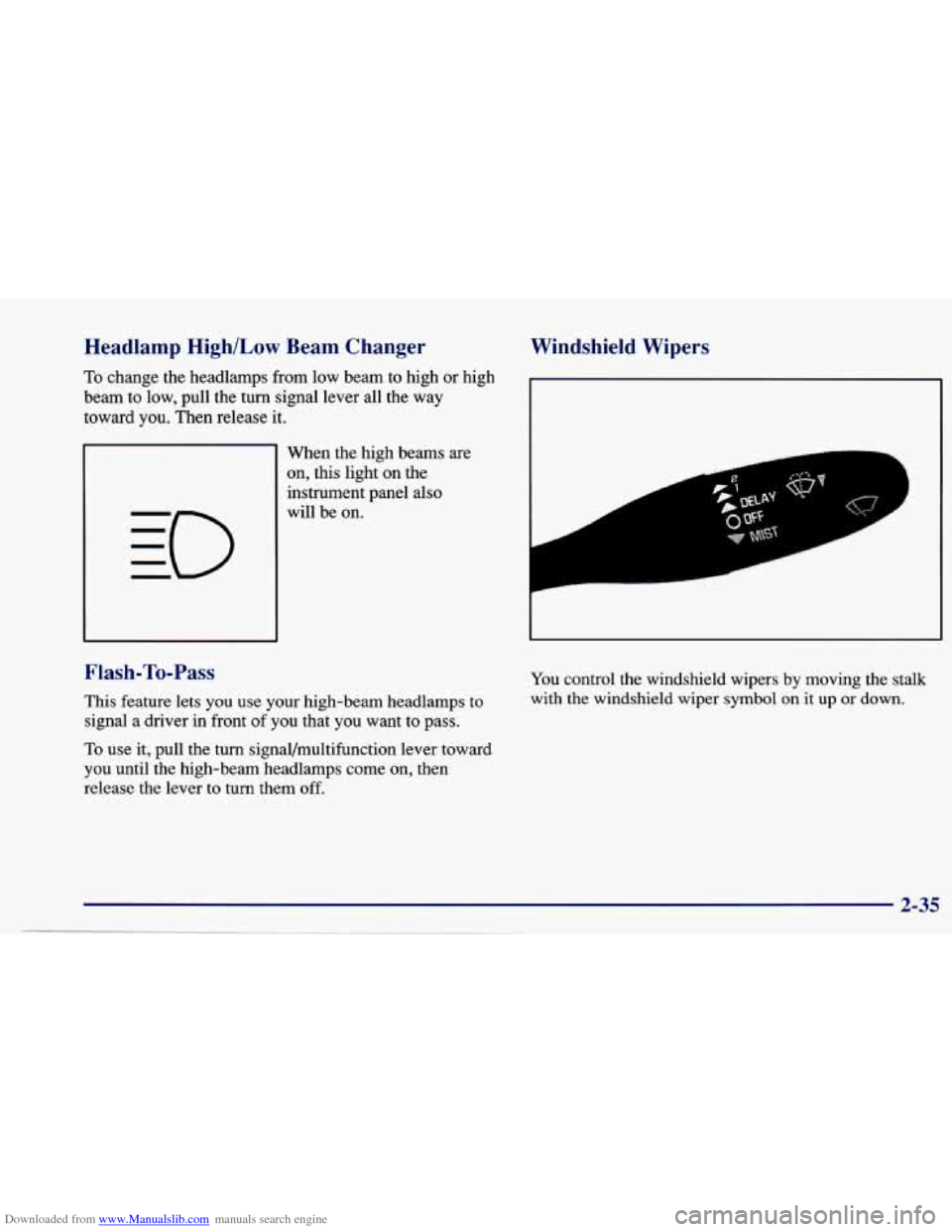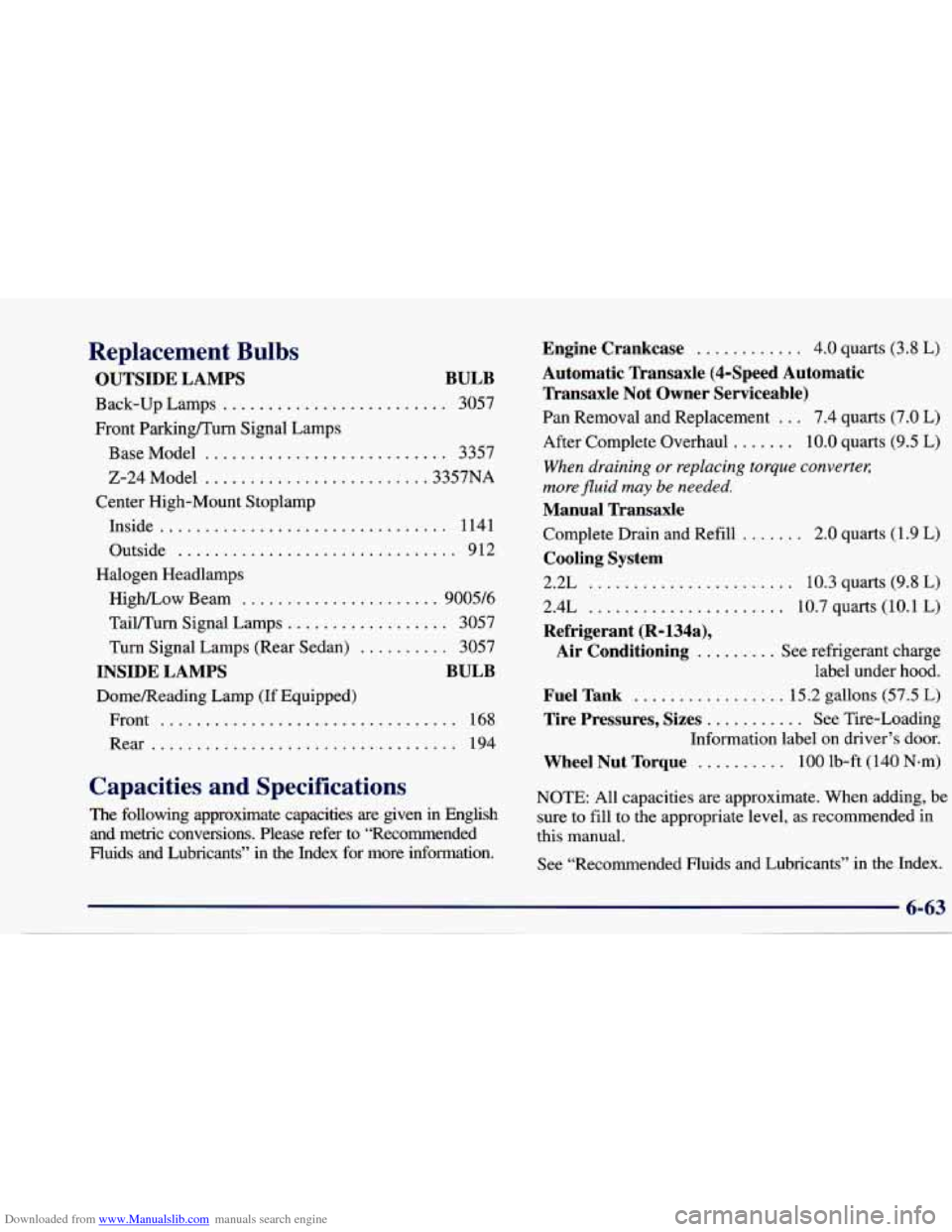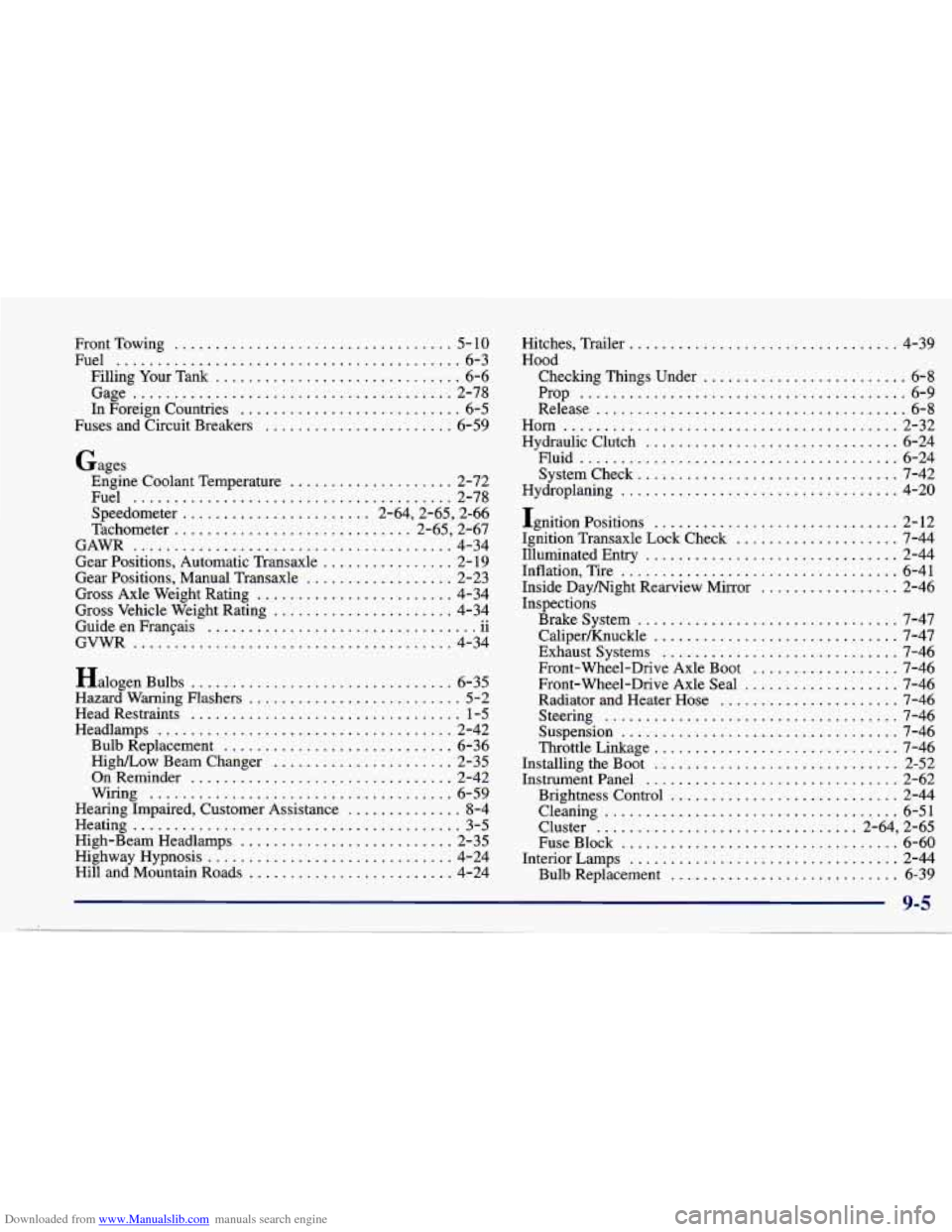1997 CHEVROLET CAVALIER low beam
[x] Cancel search: low beamPage 91 of 388

Downloaded from www.Manualslib.com manuals search engine Tilt Steering Wheel (If Equipped) Turn Signal/Multifunction Lever
A tilt steering wheel allows you to adjust the steering
wheel before you drive.
You can also raise it to the
highest level to give your legs more room when you exit
and enter the vehicle.
To tilt the wheel, hold the steering wheel and pull the
lever. Move the steering wheel to a comfortable level,
then release the lever to lock the wheel in place. The
lever on the left side
of the steering column
includes your:
Turn Signal and Lane Change Indicator
0 Headlamp Highbow Beam Changer
Cruise Control (If Equipped)
2-33
Page 93 of 388

Downloaded from www.Manualslib.com manuals search engine Headlamp High/Low Beam Changer
To change the headlamps from low beam to high or high
beam to low, pull the
turn signal lever all the way
toward you. Then release it.
When the high beams are
on, this light on the
instrument panel also
will be on.
Flash-To-Pass
This feature lets you use your high-beam headlamps to
signal a driver in front
of you that you want to pass.
To use it, pull the turn signal/multifunction lever toward
you until the high-beam headlamps come on, then
release the lever to turn them off.
Windshield Wipers
You control the windshield wipers by moving the stalk
with the windshield wiper
symbol on it up or down.
2-35
Page 100 of 388

Downloaded from www.Manualslib.com manuals search engine Parking Lamps
PC This position will turn on the following:
0 Parking Lamps
0 Sidemarker Lamps
0 Taillamps
0 Instrument Panel Lights
Headlamps
0: This position will turn on the following:
0 Headlamps
0 Parking Lamps
Sidemarker Lamps
Taillamps
0 Instrument Panel Lights
Turn the band clockwise all the way to turn the lamps off.
Lamps On Reminder
If you open the driver’s door with the ignition off and
the lamps on, you will hear a warning chime.
Daytime Running Lamps/Automatic
Light Control
Daytime Running Lamps (DRL) can make it easier for
others to
see the front of your vehicle during the day.
DRL can be helpful in many different driving
conditions, but they can be especially helpful in the
short periods after dawn and before sunset.
The DRL system will make your high-beam headlamps
come on at reduced brightness in daylight when:
The ignition is on with the engine running,
0 The headlamp switch is OFF,
0 The parking brake is released and
0 The transaxle is not in PARK (P) on models with an
automatic transaxle.
This indicator light on your
instrument panel comes on
when the DRL are on.
Page 101 of 388

Downloaded from www.Manualslib.com manuals search engine A flashing DRL telltale indicates a possible burned out
headlamp, or that the vehicle may need service to repair
a stuck DRL relay.
When the
DRL are on, only your high-beam headlamps
will be
on at reduced brightness. The taillamps,
sidemarker and other lamps won’t be on. Your
instrument panel won’t be lit up either.
When you turn on the headlamp switch, your high-beam
headlamps will go out, and your headlamps will come
on. The other lamps that come on with your headlamps
will also come on.
When you turn
off the headlamp switch, the regular
lamps will go
off, and your high-beam headlamps will
come on at reduced brightness.
To idle your vehicle with the DRL off, set the parking
brake. The DRL will stay off until you release the
parking brake.
As with any vehicle, you should turn on the regular
headlamp system when
you need it.
Fog Lamps (If Equipped)
Use your fog lamps for better vision in foggy or
misty conditions.
The switch for
your fog lamps is next to the instrument
panel intensity control.
Push the top
of the switch to turn the fog lamps on. Push
the bottom of the switch
to turn the fog lamps off.
When using fog lamps, the parking lamps or low-beam
headlamps must be on.
Fog lamps will go off whenever the high-beam
headlamps come on. When the high beams go off, the
fog lamps will come
on again.
2-43
Page 179 of 388

Downloaded from www.Manualslib.com manuals search engine Night Vision
No one can see as well at night as in the daytime. But as
we get older these differences increase.
A 50-year-old
driver may require at least twice
as much light to see the
same thing at night as a 20-year-old.
What you
do in the daytime can also affect your night
vision. For example, if you spend the day in bright
sunshine you are wise to wear sunglasses. Your eyes will
have less trouble adjusting to night. But
if you’re
driving, don’t wear sunglasses at night. They may cut
down on glare from headlamps, but they also make a lot
of things invisible.
You can be temporarily blinded by approaching
headlamps. It can take a second
or two, or even several
seconds, for your eyes to readjust to the dark. When you
are faced with severe glare (as from a driver who
doesn’t lower the
high beams, or a vehicle with
misaimed headlamps), slow down
a little. Avoid staring
directly into the approaching headlamps. Keep your windshield and
all the glass on your vehicle
clean
-- inside and out. Glare at night is made much
worse by dirt
on the glass. Even the inside of the glass
can build up a film caused by dust. Dirty glass makes
lights dazzle and flash more than clean glass would,
making the pupils
of your eyes contract repeatedly.
Remember that your headlamps light up
far less of a
roadway when you are in
a turn or curve. Keep your
eyes moving; that way, it’s easier to pick out dimly
lighted objects. Just as your headlamps should be
checked regularly for proper aim,
so should your eyes
be examined regularly. Some drivers suffer from night
blindness
-- the inability to see in dim light -- and
aren’t even aware of it.
Page 182 of 388

Downloaded from www.Manualslib.com manuals search engine Hydroplaning
Hydroplaning is dangerous. So much water can build up
under your tires that they can actually ride on the water.
This can happen if the road is wet enough and you’re
going fast enough. When your vehicle is hydroplaning,
it has little or no contact with the road.
Hydroplaning doesn’t happen often. But
it can if your
tires
do not have much tread or if the pressure in one or
more is low. It can happen if a lot of water is standing on
the road. If you can see reflections from trees, telephone
poles
or other vehicles, and raindrops “dimple” the
water’s surface, there could be hydroplaning.
Hydroplaning usually happens at higher speeds. There
just isn’t a hard and fast rule about hydroplaning.
The
best advice is to slow down when it is raining.
Driving Through Deep Standing ’ ater
NOTICE:
If you drive too quickly through deep puddles
or standing water, water can come in through
your engine’s air intake and badly damage your engine. Never drive through water that is slightly
lower than the underbody
of your vehicle. If you
can’t avoid deep puddles or standing water, drive
through them very slowly.
Some Other Rainy Weather Tips
Turn on your low-beam headlamps -- not just
your parking lamps
-- to help make you more
visible to others.
0
Besides slowing down, allow some extra following
distance. And be especially careful when you pass
another vehicle. Allow yourself more clear room
ahead, and be prepared to have your view restricted
by road spray.
Have good tires with proper tread depth. (See
“Tires” in the Index.)
Page 305 of 388

Downloaded from www.Manualslib.com manuals search engine Replacement Bulbs
OUTSIDE LAMPS BULB
Back-up Lamps ......................... 3057
Front Parking/Turn Signal Lamps
BaseModel
........................... 3357
2-24Model
......................... 3357NA
Center High-Mount Stoplamp
Inside
................................ 1141
Outside
............................... 9 12
Halogen Headlamps High/Low Beam
...................... 9005/6
TaiVTurn Signal Lamps
.................. 3057
Turn Signal Lamps (Rear Sedan)
.......... 3057
INSIDE LAMPS BULB
Domemeading Lamp (If Equipped)
Front
................................. 168
Re x.................................. 194
Capacities and Specifications
The following approximate capacities are given in English
and metric conversions.
Please refer to “Recommended
Huids
and Lubricants” in the Index for more information.
Engine Crankcase ............ 4.0 quarts (3.8 L)
Automatic Transaxle (4-Speed Automatic
Transaxle Not Owner Serviceable)
Pan Removal and Replacement ... 7.4 quarts (7.0 L)
After Complete Overhaul ....... 10.0 quarts (9.5 L)
When draining or replacing torque converter;
more fluid may be needed.
Manual Transaxle
Complete Drain and Refill ....... 2.0 quarts (1.9 L)
Cooling System
2.2L ....................... 10.3 quarts (9.8 L)
2.4L
...................... 10.7 quarts (10.1 L)
Refrigerant (R=134a),
Air Conditioning
......... See refrigerant charge
label under hood.
Fuel Tank ................. 15.2 gallons (57.5 L)
Tire Pressures, Sizes ........... See Tire-Loading
Information label
on driver’s door.
Wheel Nut Torque .......... 100 lb-ft (140 Nem)
NOTE: All capacities are approximate. When adding, be
sure to fill to the appropriate level, as recommended in
this manual.
See “Recommended Fluids and Lubricants” in the Index.
Page 379 of 388

Downloaded from www.Manualslib.com manuals search engine FrontTowing .................................. 5-10
Fuel .......................................... 6-3
Filling Your Tank
.............................. 6-6
Gage ....................................... 2-78
In Foreign Countries
........................... 6-5
Fuses and Circuit Breakers ....................... 6-59
Gages Engine Coolant Temperature
.................... 2-72
Fuel
....................................... 2-78
Speedometer
....................... 2-64.2-65. 2.66
Tachometer
............................. 2.65. 2.67
GAWR
....................................... 4-34
Gear Positions. Automatic Transaxle
................ 2- 19
Gear Positions. Manual Transaxle
.................. 2-23
Gross Axle Weight Rating
........................ 4-34
Gross Vehicle Weight Rating
...................... 4-34
Guide en Frangais
11 .. .................................
GVWR ....................................... 4-34
Halogen Bulbs
................................ 6-35
Hazard Warning Flashers
.......................... 5-2
Head Restraints
................................. 1-5
Headlamps .................................... 2-42
Bulb Replacement
............................ 6-36
High/Low Beamchanger
...................... 2-35
OnReminder
................................ 2-42
Wiring
..................................... 6-59
Hearing Impaired. Customer Assistance
.............. 8-4
High-Beam Headlamps
.......................... 2-35
Highway Hypnosis
.............................. 4-24
Hill and Mountain Roads
......................... 4-24
Heating
........................................ 3-5 Hitches.
Trailer 4-39
Hood Checking Things Under
......................... 6-8
Release ...................................... 6-8
Hydraulic Clutch ............................... 6-24
Fluid
....................................... 6-24
..
.................................
Prop ........................................ 6-9
Horn ......................................... 2-32
System Check
................................ 7-42
Hydroplaning
.................................. 4-20
Ignition Positions
.............................. 2-12
Ignition Transaxle Lock Check
.................... 7-44
Inflation, Tire
.................................. 6-41
Inside Daymight Rearview Mirror
................. 2-46
Inspections Brakesystem
................................ 7-47
Caliper/Knuckle
.............................. 7-47
Exhaust Systems
............................. 7-46
Front-Wheel-Drive Axle Boot
.................. 7-46
Front-Wheel-Drive Axle Seal
................... 7-46
Radiator and Heater Hose
...................... 7-46
Steering
.................................... 7-46
Suspension
.................................. 7-46
Throttle Linkage
.............................. 7-46
InstrumentPanel
............................... 2-62
Brightness Control
............................ 2-44
Cleaning
.................................... 6-51
Cluster
................................ 2-64, 2-65
FuseBlock
.................................. 6-60
Interior Lamps ................................. 2-44
Bulb Replacement ............................ 6-39
Illuminated Entry
............................... 2-44
Installing the Boot
.............................. 2-52
9-5